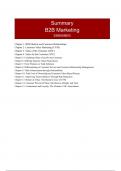Summary
(Book) Summary B2B (EBM808B05) - All mandatory chapters (B2B Customer Value Marketing - the essentials)
- Course
- Institution
This extensive summary contains all mandatory chapters of the book "B2B Customer Value Marketing -the essentials", (by Dr Jean-Pierre Thomassen). Only chapter 12 will not be discussed, due to the fact that this will not be exam material. The other 14 (!) chapters are discussed in detail. The docume...
[Show more]



